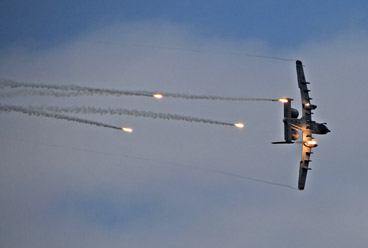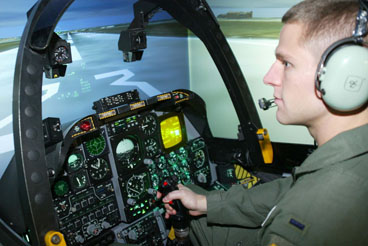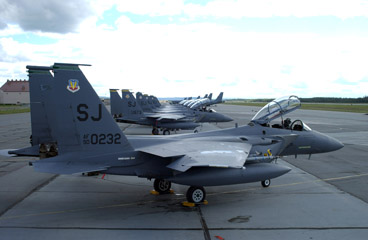Faced with the double blow of rising costs and stagnant funding, today’s Air Force is looking for savings everywhere, and that includes some areas that traditionally have been off-limits to budget-cutters.
The best example is the Air Force flying hour budget—the funding used to pay for live flight training. This particular pot of money had long been held sacrosanct and nearly untouchable. However, even flying hours are being scaled back.
In 2005, the Pentagon told USAF it must use service funds, rather than separate DOD allocations, to pay for Operation Noble Eagle, the post 9/11 domestic combat air patrols over US cities. Noble Eagle had been financed through wartime supplementals.
Air Mobility Command began slashing its training flights that same year. Likewise, Pacific Air Forces cut flight training by about 9,000 hours in 2005, shaving its bill by $50 million, about nine percent of its flying budget. Others followed suit.
 |
An A-10 Thunderbolt fires flares in a combat search and rescue training exercise. (USAF photo by A1C Chad Strohmeyer) |
Now, the Fiscal 2008 budget is setting a risky precedent. The spending blueprint calls for cutting overall flying hours by 10 percent across the board. According to Air Combat Command officials, decreased flying hours are forecasted for all missions except testing and intelligence gathering. No platform in the combat fleet is getting an increase in hours.
Air Force leadership is far from comfortable with the situation and is squeezing dollars where they can find them for flying hours. As of December, the Air Staff was pushing to bring back up the flight hours for the 2009 fiscal year, indicating that funds would be shifted out of some military construction projects. However, the flying hour program for 2010 and beyond remains in question.
Air Force leaders aren’t happy about all of this.
“We have continued to dumb down the standard until we’ve reached a point where we are not producing the sorties,” Gen. T. Michael Moseley, USAF Chief of Staff, told a House panel this year. “Nor are we producing the total combat preparation that I’m comfortable with.”
Service leaders are uneasy about the effect of these cuts. Less time in the air has been a contributor to the decline of readiness levels in recent years, they note.
As flight hours decline, the combat air forces are increasingly relying for their aircrew training on high-fidelity simulators. Modern simulators are a powerful training tool, said Col. Eric H. Best, head of the flight operations division at Air Combat Command, Langley AFB, Va. However, he added, they are no cure-all.
Lt. Gen. Raymond E. Johns Jr., the Air Force’s deputy chief of staff for strategic plans and programs, reports that recent flying hour cuts have degraded the ability of some aircrews to drop weapons, and the service needs to find a way to get the hours back up in the budgets for Fiscal 2009 and 2010.
Moreover, the simulator can never fully reproduce the so-called “wow factor” produced by the launch of a live weapon. In combat, Johns noted, pilots “don’t have time for a ‘wow factor,’ ” because they are too busy flying and fighting.
 |
SrA. Adam Mirabal gives signals to the pilot of a B-52 as part of Operation Enduring Freedom. (USAF photo by SSgt. Doug Nicodemus) |
Another problem: High-fidelity simulators are not available in large numbers. “We are trying to take legacy systems and turn them into high-fidelity systems,” said Best. “It doesn’t do us any good to send a guy into a simulator that’s not configured the same as what’s on the flight line.”
Today, only a few platforms have hardware and software deemed good enough to substitute for actual training sorties. As of October, ACC could provide this level of simulation to only the pilots of its E-3 AWACS, F-15 fighter, and Block 50 F-16 fighter.
Still, those few simulators provide a great deal of capability. Currently, 25 percent of AWACS crew hours are being “flown” in simulators. F-15 pilots can accumulate as much as 20 percent of their required training sorties in simulators.
Hi-Tech Simulators
The capability of some modern simulators makes possible the execution of even highly challenging training scenarios. “I can do things in a simulated environment that I’ve never done in almost 4,000 hours in an F-16,” Best said.
Still, there are limits. “I can’t simulate what it’s like to take off when the weather is near zero on a mission,” said Best. “I can’t simulate when you start hearing weird noises and looking at gauges doing strange things.” For those situations, nothing can match the actual flight experience.
 |
First Lt. Joden Werlin, 75th Fighter Squadron, Langley AFB, Va., focuses on the controls of an A-10 simulator as he prepares to participate in a Virtual Red Flag exercise. (USAF photo by Lisa Terry McKeown) |
To help map out its yearly flight regimen, ACC produces a single Air Force flying model that takes into account aircrew experience level, type of aircraft, and many other factors, and then spits out the number of yearly flying hours needed for a given platform.
In 2007, Air Combat Command aircraft flew 327,794 hours of all types. The majority of the flying hours came out of the command’s budget, but about 60,000 hours were flown under the category of “contingency flights”—meaning operations in Iraq or Afghanistan.
A portion of the “contingency” flying hours come out of the ACC training budget, with the remainder funded by supplementals. In 2007, only 12,000 of the Air Force’s 60,000 contingency flying hours were funded by war supplementals.
Future budgets remain tight. Starting in 2008, the service has 261,348 flight hours on the books for the combat fleet. Going forward through 2013, the budget will fluctuate but not by much - with an average of 260,000 hours a year. In December, however, Air Staff officials indicated they would be rolling back cuts to the FY 2009 flying hour program but gave no specifics on recapturing flight hours in the out years.
Overseas rotations take a toll on overall readiness. When a squadron is slated for a predeployment training cycle, pilots perform their buildup to get ready for the specific missions they are expected to perform when they deploy. Deployment spin-up training is “just a subset of capabilities,” Best said—preparation for what the aircrews will need over Iraq or Afghanistan.
Best, a former operations group commander at the 8th Fighter Wing, Kunsan AB, South Korea, noted that a Korean deployment requires different mission sets and capabilities than what are currently needed over Southwest Asia, where there is no air-to-air threat or integrated air defense system to defeat.
In the four months before a unit leaves, commanders will look at what the unit will be tasked to do, and the operators will train to those missions—at the expense of everything else.
 |
F-16s on the flight line at Duluth Arpt., Minn. These F-16s are assigned to the 148th Fighter Wing “Bulldogs.” (USAF photo by SrA. Donald L. Acton) |
When this happens, other skills atrophy. “We accept risk in some of those missions; we know there is going to be some spin-up time before we can execute,” Best pointed out. Commanders are forced “to make hard choices.”
Getting units back up to mandated readiness levels takes close adherence to a building block approach that closely monitors which missions and skills are needed imminently. “It’s something we are good at, but it takes a conscientious management of those programs,” said one Air Force officer.
Eye on the Prize
Meticulous management is particularly important for fleets that consist of very old aircraft such as the B-52, or that have limited availability, such as the B-2.
ACC planners keep their eyes on factors such as cost per flying hour, maintenance man-hours per flying hour, mission capable rates, and utilization rates to ensure platforms and their crews are properly funded.
With the F-22 program, pilots are tightly managed and previously qualified. With new Raptor units coming online, USAF wants experienced pilots in place as the Air Force stands up squadrons in Alaska, Hawaii, and New Mexico. Starting next year, however, the program will start admitting pilots fresh out of training, which will complicate the equation.
“I’m sure we’ll learn a few things,” Best said.
Working training into the rotations of in-demand combat aircraft—such as bombers and close air support fighters—takes even greater care and attention to detail.
 |
Capt. Matt Buckner, 71st Fighter Squadron, flies an F-15 on a combat air patrol mission over Washington, D.C., as part of Operation Noble Eagle. (USAF photo by SSgt. Samuel Rogers) |
Maj. Kent L. Payne of ACC’s flight operations division said deployment management is vital to ensuring proper readiness.
“[Before] this calendar year, the B-1 was on a four-month deployment and eight months at home station,” said Payne, himself a B-1B operator. “Those eight months at home, we were training up on other missions, [but] not getting enough spin-up for going back to theater.”
Earlier this year, the B-1B went to a six-month-long deployment cycle, with one year at home station. The extra time in the US helped fill in the training gaps that arose when older, more-experienced crews deployed, leaving behind younger officers who had not completed mission qualification.
Bombers fly fewer but longer training sorties, Payne added, and the extra time at home station is already paying off—flying hours are more evenly distributed to the airmen who need them. In a given 20-month Air and Space Expeditionary Force (AEF) cycle, a less-experienced B-1 pilot needs at least 80 training sorties in the air. An experienced pilot only requires 60 sorties.
Highly tasked assets, such as the A-10 attack aircraft, confront major training challenges on two fronts—coordinating home station training with deployments and making sure maintainers can provide healthy aircraft for training. “We are going to two theaters,” Iraq and Afghanistan, on six-month deployments, said Maj. George Stanley, the ACC flight operations division section chief for A-10 training.
Fighter crews fly more and shorter sorties than do their bomber counterparts. For A-10 pilots, the minimum sortie requirement in an AEF cycle for a less-experienced flier is about 180 sorties, with more experienced pilots needing 160 flights.
When the A-10s return from deployments, they have a large assignment portfolio, but no longer have priority for parts, such as targeting pods and other equipment. Furthermore, there are only four deployable active duty units.
National Guard to the Fore
If an A-10 unit deploys 12 of its aircraft, for example, those aircraft need 100 percent manning to support the mission, Stanley said. As a result, home-station training must be scaled back, since a squadron cannot generate the sortie rate without an adequate number of maintainers.
Fortunately, the Air National Guard is able to assist with the A-10 mission. Just this fall, ANG units from Maryland and Michigan were deployed to the US Central Command region with their recently upgraded A-10Cs, helping to spread the training and deployment burden while putting the most capable aircraft in the combat zones.
 |
F-15s lined up on the flight line await a Red Flag Alaska mission at Eielson AFB, Alaska. (USAF photo by Capt. Tana R.H. Stevenson) |
ACC’s flight operations division has been searching for solutions to the nagging funding shortage. Earlier this year, Moseley directed that fighter and bomber units no longer be deliberately overmanned—a change greeted with relief at Best’s office.
When a squadron is overmanned, the flying hours requirement goes up along with the manning level. “If I have 125 percent ... manning, then my requirements for hours are 25 percent greater,” Best said. The change is “going to help with my sortie generation requirement.”
There was no excess capacity to go around. Not all aircrews were meeting their minimum training levels. One hundred percent manning helps spread resources “across the right population,” Best said. “I get better distribution across my aircrews; I get better currency.”
But shedding manpower is tricky. When flying units cut personnel to correct overmanning, the first to go are the more experienced fliers—who are useful in other assignments—to make room for pilots coming out of flight training.
The “brand-new beans” to the system now have to go through the training program quicker to close the experience gap, Best said. Pilots with 300 or 400 hours on a given airframe are replaced with pilots who may have 70 hours—and more training hours are required for these new pilots than for experienced operators.
If not managed correctly, this shift in experience levels can affect the quality of training, Best added.
In the coming years, Air Combat Command’s flight operations office at Langley will exert more authority over USAF’s training portfolio, fleetwide, in an attempt to get the force in line with requirements.
Beginning in this year, ACC’s flight operations division is tackling US Air Forces in Europe and Pacific Air Forces flying hour planning as well. The hope is that consolidated planning will help equalize the flying hours across the combat fleet.
Copyright Air Force Association. All rights reserved.